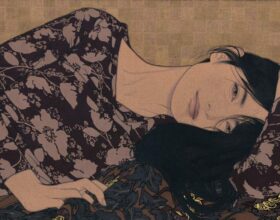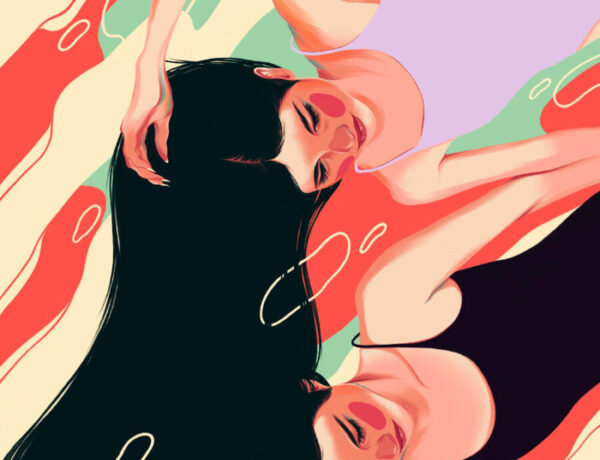Leave the Louvre behind and lose yourself in the world of new contemporary art at The New Salon. This exhibition, held at Asheville Art Museum until 19 August 2024, brings a unique, modern twist to the traditional art salon of centuries passed. Here you’ll find the works of many new contemporary artists including some of Bender Gallery’s finest talent, Laine Bachman, Kukula and Yui Sakamoto. Continue reading to learn more about Laine, Kukula and Yui’s thoughts on the new contemporary genre and take a glimpse into their fabulous bodies of work currently on show at The New Salon.
The New Salon – A Contemporary View
Exhibition Dates: March 8– 19 August, 2024
Asheville Art Museum
Asheville Art Museum | Appleby Foundation Exhibition Hall, 2 South Pack Square, Asheville, NC, 28801
Opening hours: Mondays, Wednesdays, Fridays, Saturdays and Sundays 11am – 6pm and Thursdays 11am – 9pm
For inquires please contact Asheville Art Museum on their contact page: https://www.ashevilleart.org/contact/
About The New Salon
The New Salon takes the tradition of the salon in art history as a site of rebellion against the norm, infusing it with the diverse and often fantastical narratives prevalent in New Contemporary figurative art. This exhibition, guest-curated by Gabriel Shaffer, features an eclectic mix of artists working in pop surrealism, street art, and graffiti, among others.
The New Salon features works from a broad range of artists including the photorealistic and surreal paintings of Robert Williams, Medieval-inspired works by Daniel Martin Diaz, and the robot-like Deities of Kumkum Fernando. Notable artists such as Mab Graves, Kukula, Lori Nelson, and Todd Schorr exemplify pop surrealism’s figurative techniques and fantastical narratives. Shepard Fairey represents street art, and the renowned New York-based writer Faust demonstrates the hand style of graffiti. Folk art and Americana find expression in the works of Dennis McNett (Wolfbat), MSRA, Ben Venom, and Rachel O’Donnell.
Bender Gallery Associate Amanda Kendrick-Deemer conducted short interviews with each of Bender Gallery’s three artists that are currently exhibited in the “New Salon” at the Asheville Art Museum.
About Laine Bachman
Laine Bachman was a very inquisitive child growing up in the rust belt of Ohio. Her mother was an avid gardener and Bachman loved exploring the plant life in the woods and the creek near her home. Ever curious, she would want to investigate beyond the easily visible, such as turning over rocks to discover the hidden worms and insects beneath them.
Bachman’s compositions are filled with the real and the mythological. Her fascination with plants and nature, along with an interest in mythology and folklore, is the fuel for her imagination. There are almost always plants and flowers, sometimes forest critters interacting with fungi, and occasionally a figure that has a touch of self-portraiture that seems to be one with nature. There are conglomerations of creatures that are posed within a setting of trees and other natural elements.
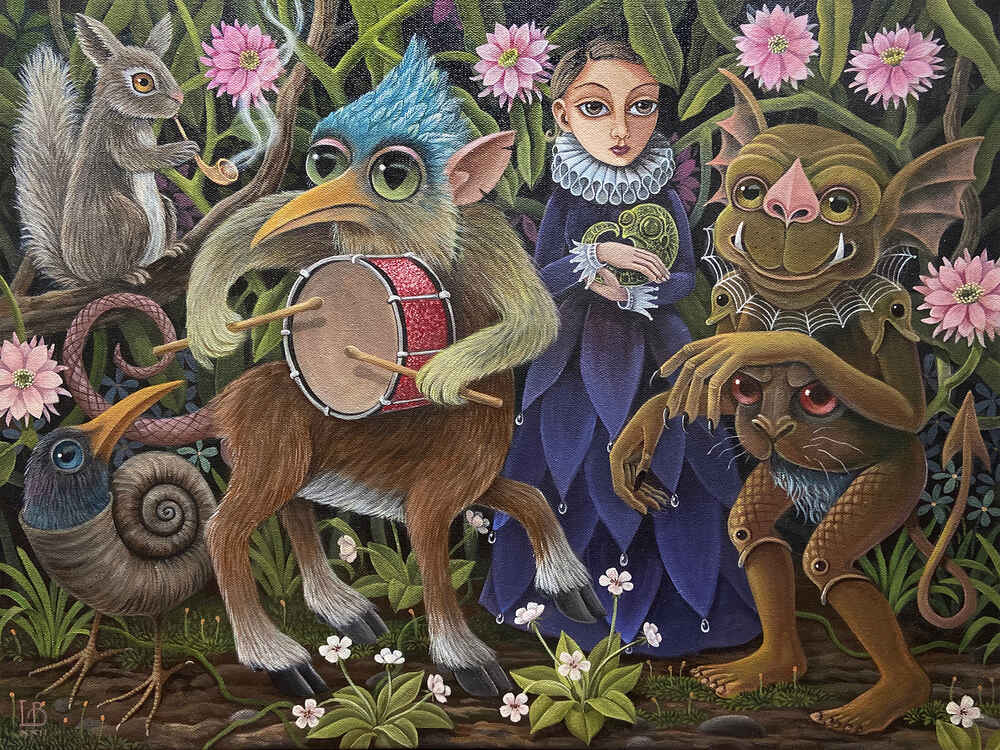
Are there certain qualities of the New Contemporary genre that you are drawn to? What are they and why?
There are so many qualities that I’m drawn to in that genre. I love that there’s no limit to what artists are able to express. It can be fantastic and surreal or abstract and tell a narrative. Really, anything goes, and I like that you can see each individual’s point of view and style. It can draw inspiration from what’s currently happening or from the past. And I just appreciate that it’s so diverse and it escapes the mundane.
The hand painted and hand cut borders in some of your paintings really amplify the overall look of the piece. Where do you draw your inspiration for those borders and what do you personally want them to do for the painting?
The borders developed as a means to frame my work in an ornate way. I used to work primarily in watercolour and wasn’t fond of a taped or deckled edge, so I started doing decorative borders instead and discovered they added a storybook quality to my work. As that aspect has evolved and I began working on canvas it’s become more experimental. Sometimes I’ll use string or cut paper or leaves from the garden to create a relief that I then foil and paint to enhance the textures. And I like that I can create this kind of gilded frame and have the imagery reaching beyond the parameters with parts of my subject breaching the border. I draw inspiration for the actual patterns from ancient motifs and carvings, or from fabric or old manuscripts and architecture. Patterns in nature are always reoccurring, too.
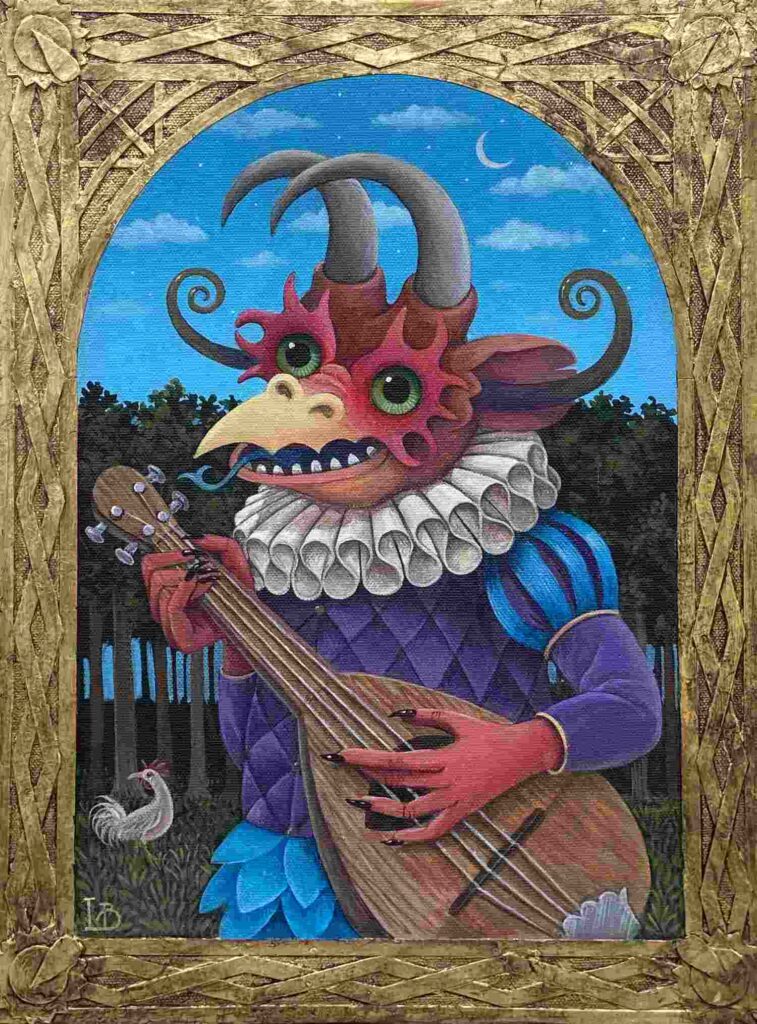
Women are central figures in many of your paintings. What does it mean for you to have powerful females or women in your paintings?
The women in my work tend to be a mother nature sort of figure and I think I’m drawn to using them as a vehicle to express my own views and fascination with the world around me. They are usually holding something that symbolizes what they hold dear to them. Or it can be seen as some sort of offering or something they’ve picked up to show. They can be seen as witches, queens or goddesses of some aspect of nature so in that sense they do become a powerful figure. I think they’re similar to religious icons or tarot cards in the way that I compose them almost like a Madonna figure or high priestess.
I get inspiration from myths and folklore, but I like to flip the story around where demons become friendly, or harpies are beautiful. Hybrid creatures are also a part of the narrative. The subjects can be two things at once for whatever reason. Are they magical or part of some strange evolution?
Can you talk about your use of mythological creatures and what messages or stories you want viewers to take away from the pieces that have those beings?
I like using mythological creatures because they become part of the narrative behind my work. I get inspiration from myths and folklore, but I like to flip the story around where demons become friendly, or harpies are beautiful. Hybrid creatures are also a part of the narrative. The subjects can be two things at once for whatever reason. Are they magical or part of some strange evolution? I enjoy setting up that duality and letting the viewer decide. It’s also a challenge to try to make these beings seem believable, and that’s something that drives my work. Touching on the thin veil between what’s real and imagined and peering into a different realm that may be familiar.
How has being a parent influenced your artmaking practice the most?
I’ve been so lucky in that aspect as far as being able to balance time with my daughter and creating art. I’ve always just worked while she’s at school or late at night which has allowed us to really do whatever we want in our free time. And I think it’s made me more disciplined, and I stick to a solid painting schedule when she’s away. I guess too there’s the mother aspect that comes through in some of my work but it’s not a conscious thing, it’s just part of my being a mom.
In addition to her painting in the New Salon, Laine Bachman currently has a solo museum exhibition at the Canton Museum of Art in Canton, OH up through to July 28, 2024.
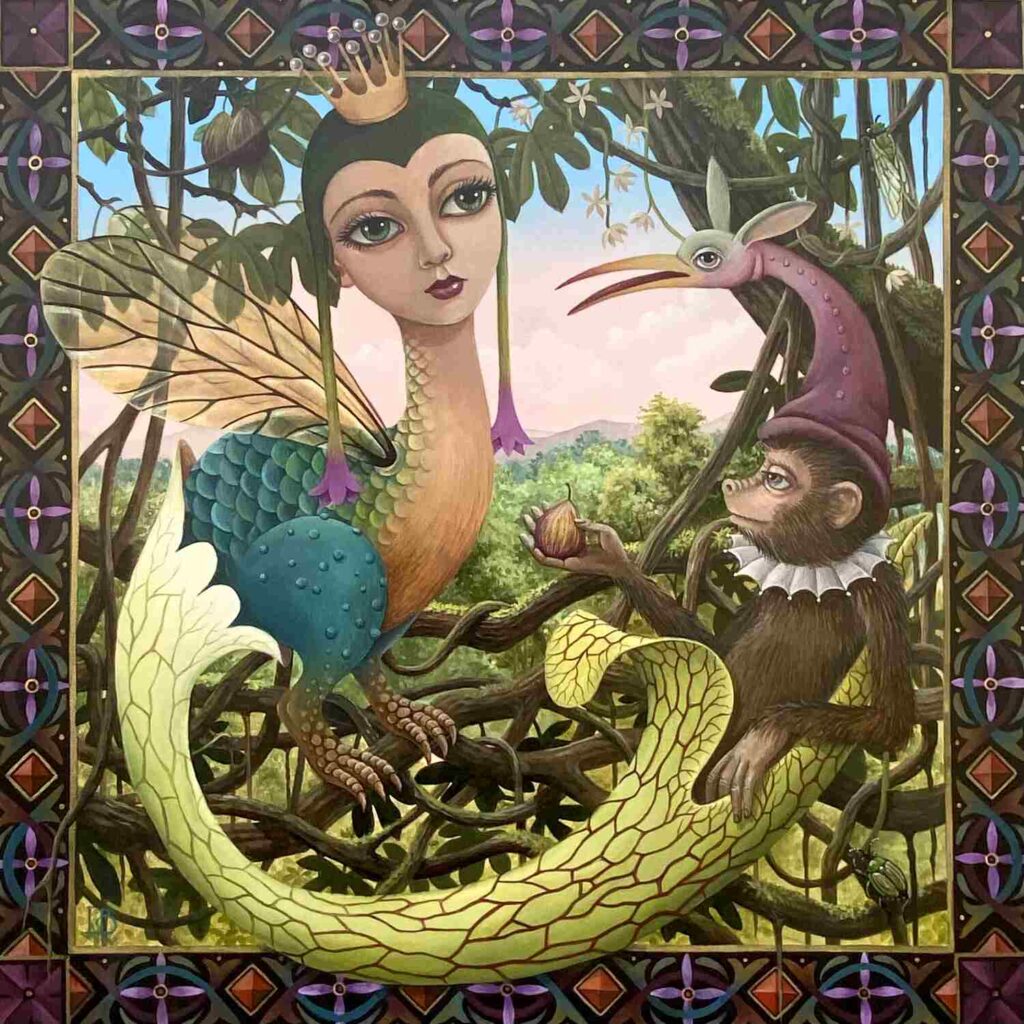
About Kukula
Artist and painter, Kukula, was born and raised about an hour from Tel Aviv, Israel in a small village. Growing up in Israel she had access to only one television channel, educational programming, therefore she watched a lot of operas and ballets. The costuming and worlds created in those performances influenced her desire to be a part of them; to get involved in the acting, music, dancing, and costuming. She participated in ballet and playing piano, but ultimately went towards illustration and then painting.
While the style of her work is heavily influenced by Rococo, Kukula adds her pop twist. Her work is mainly female-focused, and she poses her girls in a way that confronts the viewer. Limoges French porcelain is another of her inspirations. She uses the common attributes such as the pattern, filigree, or gold accents within her compositions. The filigree becomes a part of the women’s bodies. It shows that they may be fragile, but also serves as a protection from people or other elements in the world. The patterning sometimes becomes their skin, and what can be found internally is represented on the outside of their bodies. This dichotomy of beauty and the grotesque mirrors how she views her childhood of being surrounded by people telling horror stories about surviving the Holocaust, mixed with listening to fairytales and watching the visually stunning operas. Kukula received a degree in illustration from Vital-Shenkar in 2003, then moved to the U.S. in 2004. She lives in Dallas, Texas with her family.
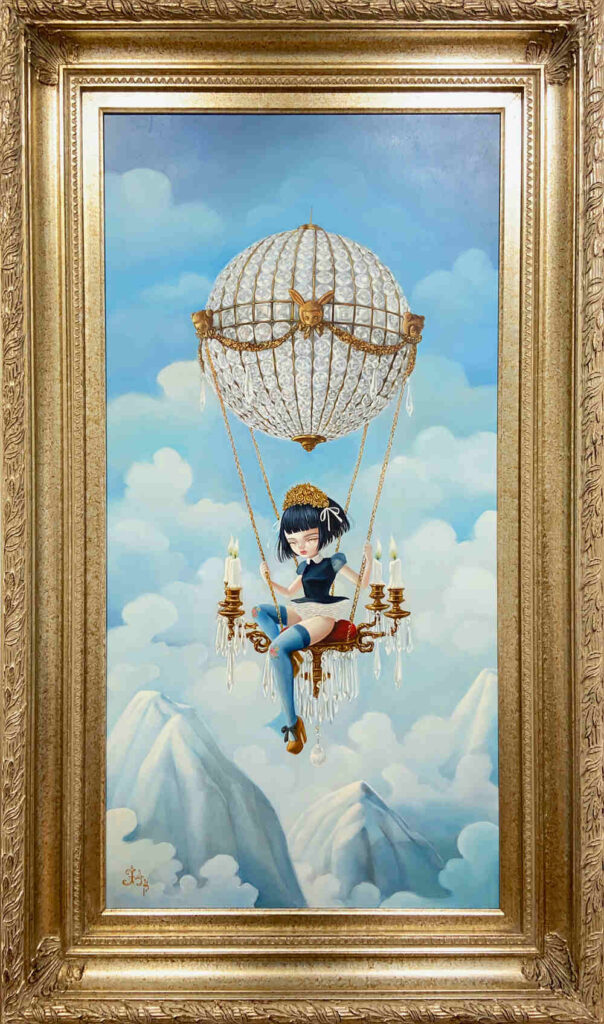
Your painting Impossible Voyage is on display at the Asheville Art Museum in The New Salon exhibition. Can you tell me a bit about the construction of Impossible Voyage?
I came across crystal hot air balloon chandeliers while looking at décor online. Instead of buying the chandelier for thousands of dollars, I made my own rendition. Décor is a big part of my life and inspiration. I was drawn to the crystal chandelier, especially because of it taking the form of a hot air balloon. It really affected me, so much so that I desired to make my own and use it as the focal point in a large painting.
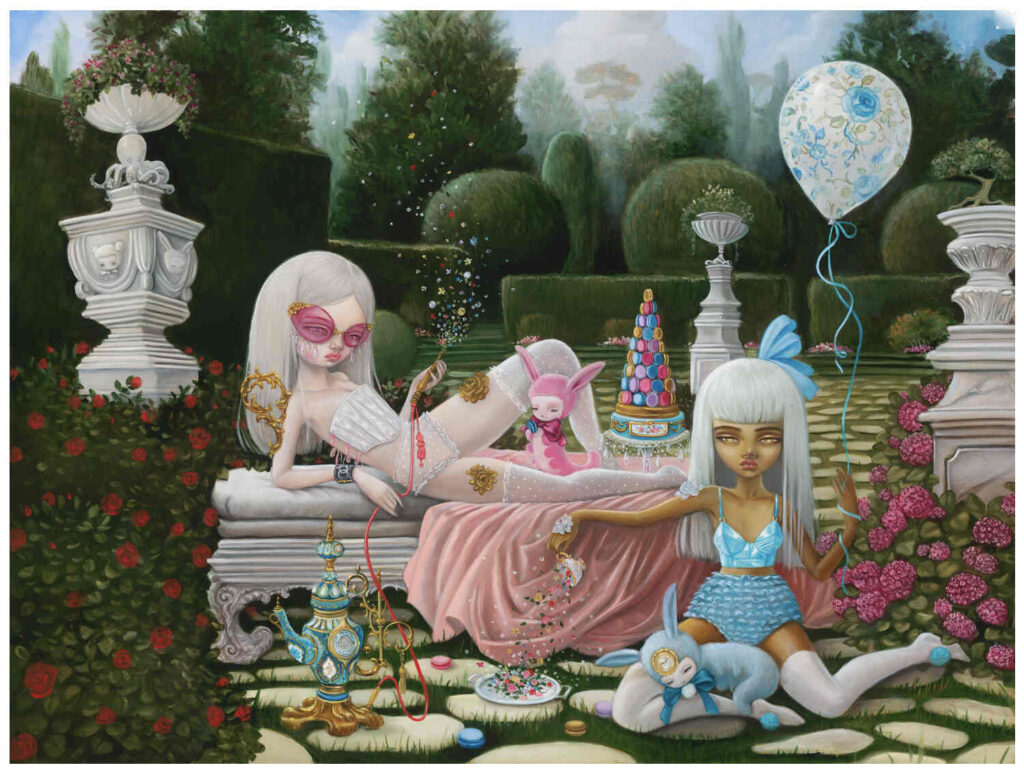
Why are balloons common in your paintings? What other symbols are you fond of using in your paintings and why?
Balloons are the innocence and fragility, the fun and the loss of childhood. They are the essence of life itself in one cheap but wonderful, mass-produced plastic waste.
Porcelain because it’s fragile but strong, it’s a contradictory material. It has the ability to have sharp details with the use of paint or glaze (difference between porcelain and ceramic). It can survive for centuries or longer.
Bunnies because they are symbols of softness and childhood. The bunny caterpillars like in Provisions are inspired by Alice in Wonderland. I draw inspiration from the story of Alice in Wonderland because although it’s a children’s book, the lessons are more mature, almost forcing children to grow up sooner than they should. The bunny caterpillars also feel like a distorted memory, which like many memories, are unreliable.
Décor, such as crystals, play a central role in my life. Because of moving around a lot, I was drawn to collecting decorative items, to give a house a feeling of home. I translate décor into feeling.
I draw inspiration from the story of Alice in Wonderland because although it’s a children’s book, the lessons are more mature, almost forcing children to grow up sooner than they should. The bunny caterpillars also feel like a distorted memory, which like many memories, are unreliable.
What are your thoughts on the New Contemporary genre as a whole?
I want to make it clear that I categorize my work to be neo-Rococo, not pop surrealism, sometimes I get lumped into that classification. Alas, they’re both under the umbrella of the new contemporary genre. To me, surrealism translates fantasy and dreams. I use pop iconography to translate my ideas. Rococo because of the aesthetic, the poses, and the colour palettes.
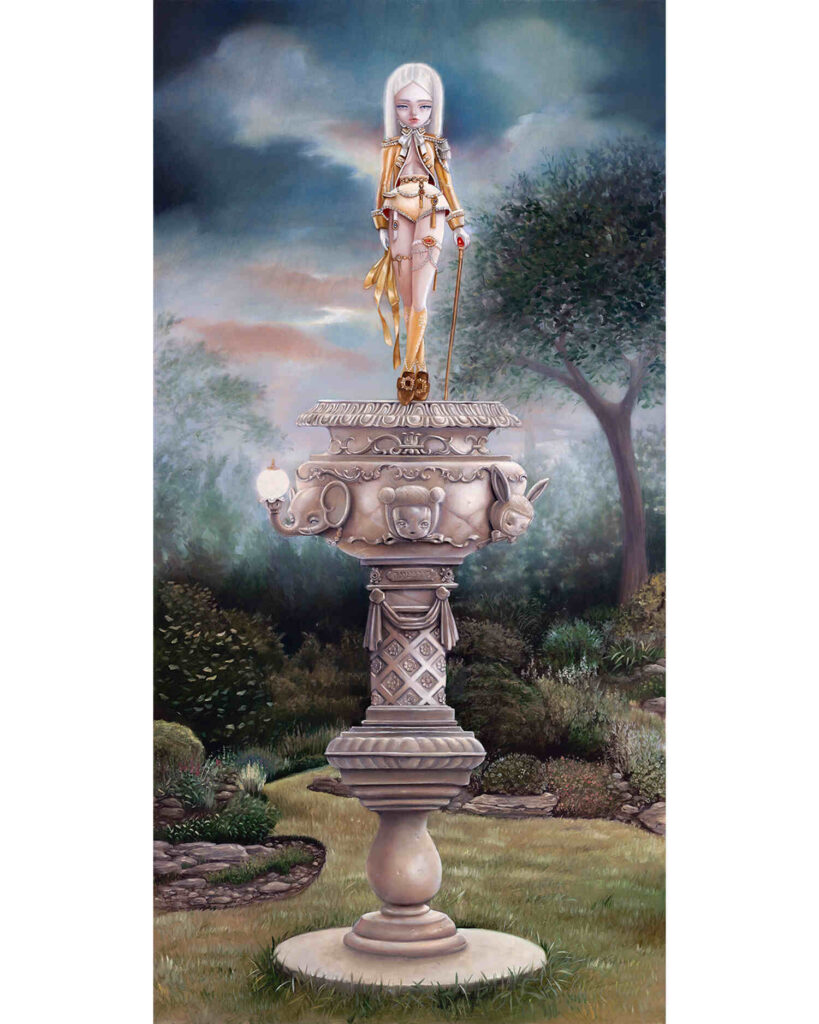
How has becoming a parent influenced your work the most?
At first it was hard just figuring out how to balance parenting with artmaking. I would paint while my daughter would sleep when she was an infant, but then those later years were more difficult. Now she is old enough that she can work on her crafts and drawings next to me while I paint.
About Yui Sakamoto
Japanese Mexican artist, Yui Sakamoto, paints large colourful and highly detailed dream-like works, carrying forward the rich history of surrealism in Mexico. With his unique dual heritage, Sakamoto seamlessly blends themes and iconography from Japanese culture, Mexican folk art, pre-Columbian artifacts, and current cultural references.
Yui Sakamoto was born in Aichi, Japan, July 1981 and grew up in Nagasaki. In 2003, Sakamoto moved to Monterrey, Mexico earning a Carrera de Arte in 2008 at the University of Monterrey. He now lives in a Japanese ex-pat community in the fittingly surreal and beautiful city of San Miguel de Allende, Guanajuato Mexico. Sakamoto’s work has been exhibited in museums and galleries in Mexico, Japan and China.
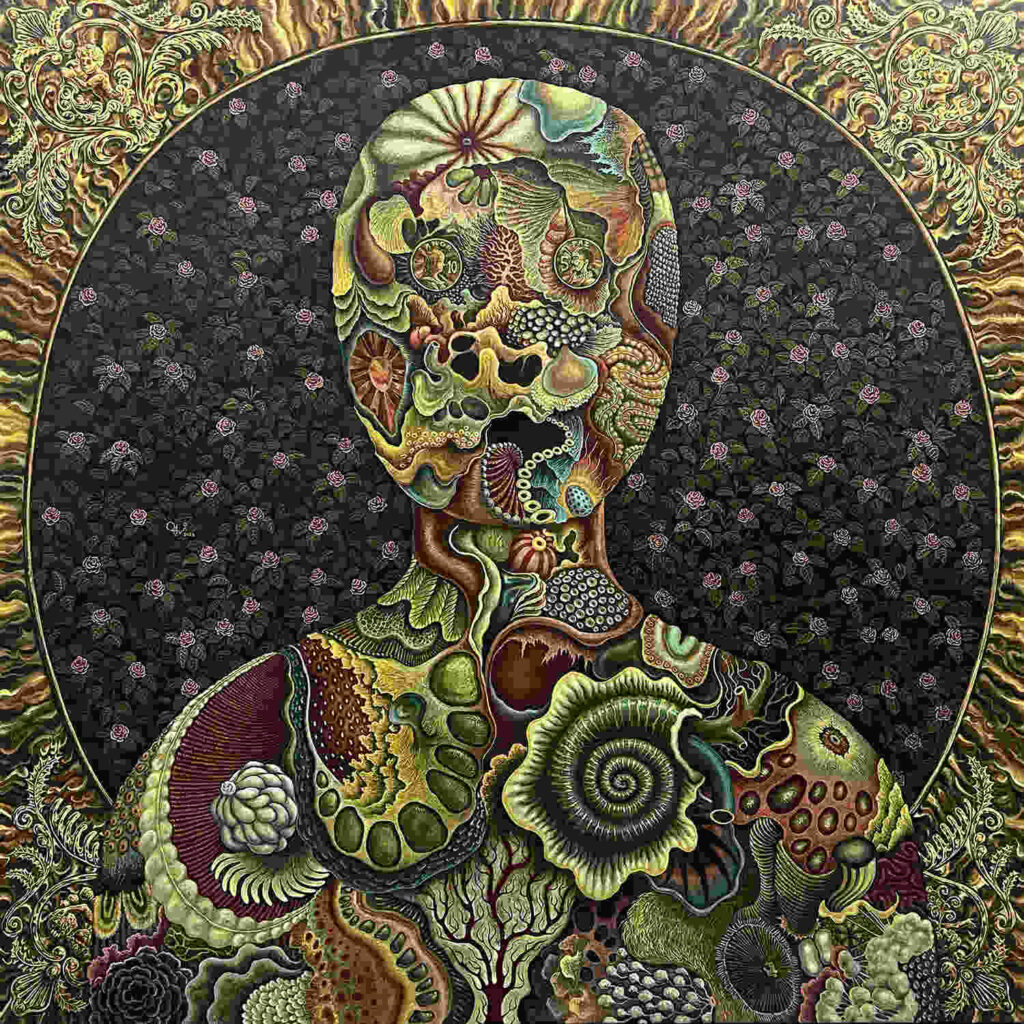
What are your thoughts on the New Contemporary genre and how it relates to the type of work you make?
I’m not interested in art. I’m a painter, I don’t consider myself an artist. I just draw the pictures I want to draw, without any concept or context in mind.
Was your painting Self Portrait always intended to be a self-portrait, or did this go through different phases during the painting process?
When I started painting this picture, my child first applied the paint to the canvas in any way he wanted. I then drew a picture of a large hand based on its colour and shape, but it started to look very boring, so I left it alone for about six months. Then, when I looked at the picture, the shape of a self-portrait began to vaguely emerge. This self-portrait was carefully drawn so as not to miss that image.
Do you work on multiple paintings at a time? Can you elaborate on why you do or do not?
Since I paint while letting the oil paint dry, there are times when I don’t touch the painting for a week or two. Therefore, I am always working on multiple paintings at the same time.
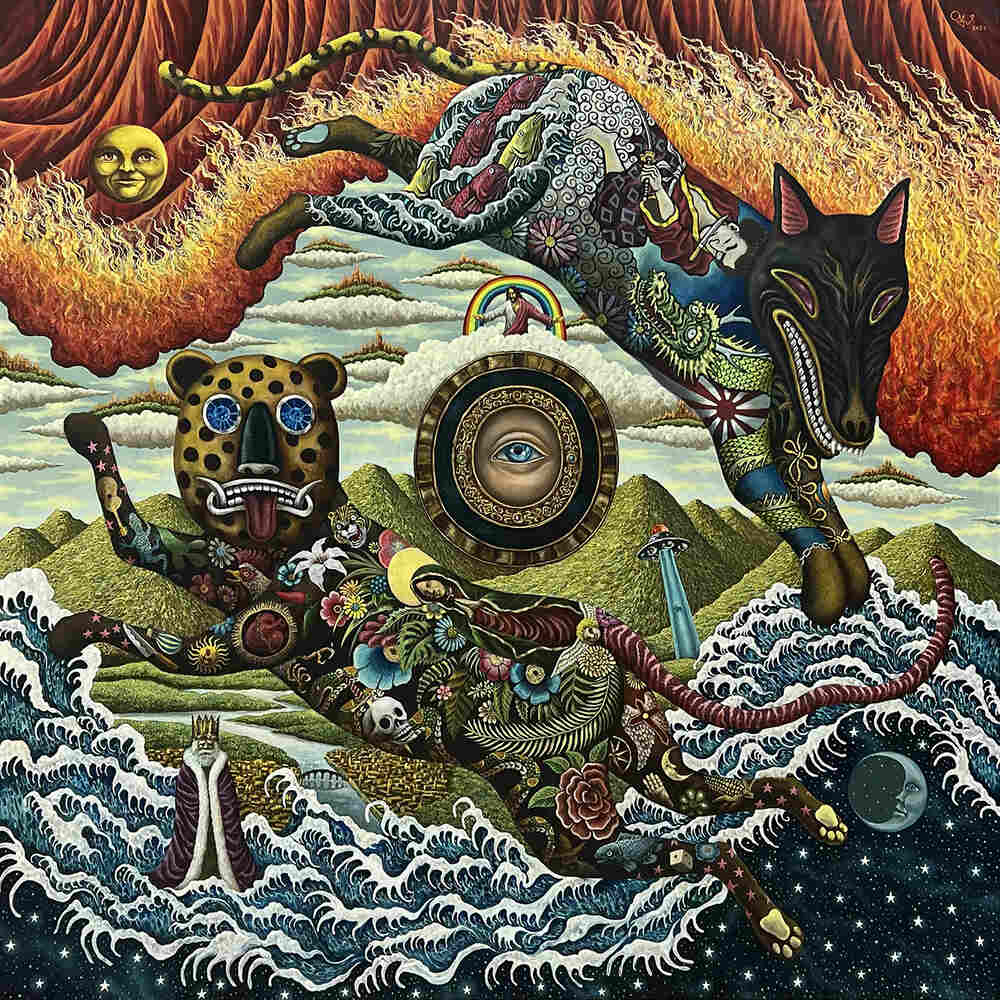
Do you believe in symbology and if so, what are some of your strongest symbols in your work, in other terms, your most used symbols?
It’s a skeleton. This is the motif I draw the most. The skeleton represents death and life at the same time. Because imagining death means thinking about life. We always think about what happens after we die through religion and science. In other words, it is connected to thinking about how to live. For me, that symbol is a skeleton.
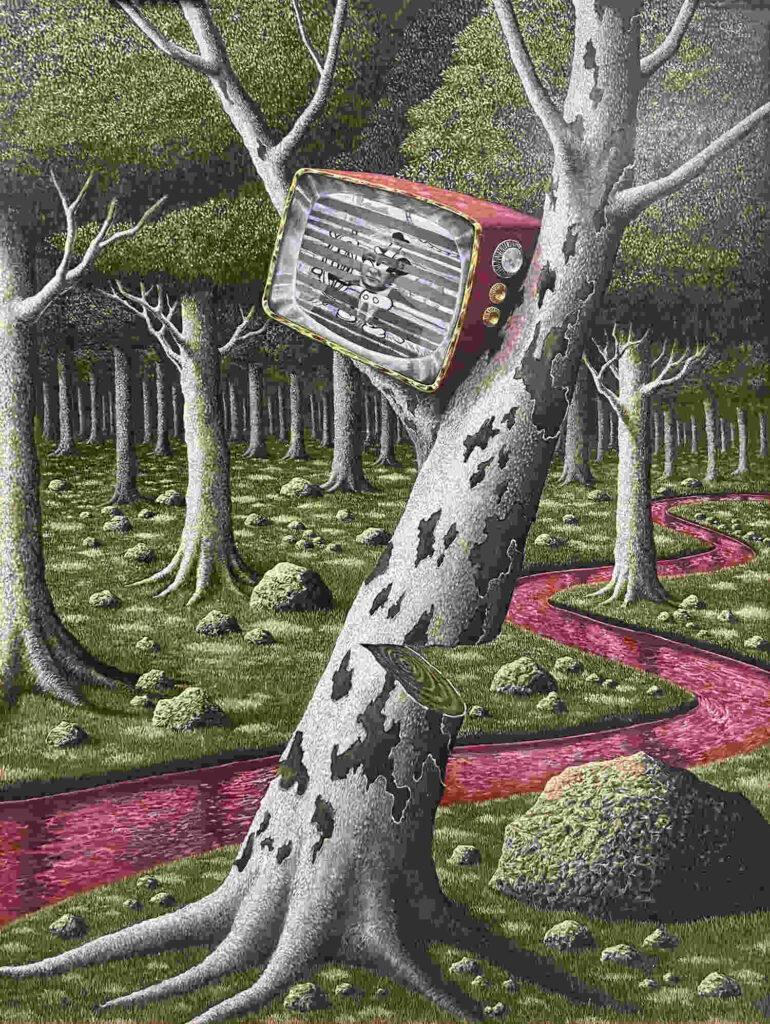
The skeleton represents death and life at the same time. Because imagining death means thinking about life.
How has becoming a parent influenced your artmaking process the most?
I am now afraid of dying and am filled with joy in living. I think they appear in my paintings.


